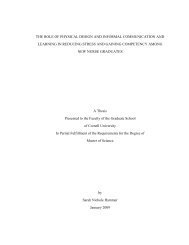The Patient Room: what is the ideal solution? - Cornell University
The Patient Room: what is the ideal solution? - Cornell University
The Patient Room: what is the ideal solution? - Cornell University
You also want an ePaper? Increase the reach of your titles
YUMPU automatically turns print PDFs into web optimized ePapers that Google loves.
Single <strong>Patient</strong> <strong>Room</strong> and <strong>Patient</strong> Sat<strong>is</strong>faction: environmental comfort<br />
Multi-bed patient rooms are reported to have higher no<strong>is</strong>e levels due to <strong>the</strong> multiple occupancy within one<br />
room, which results in more frequent consultations, v<strong>is</strong>itors, and patient communication with o<strong>the</strong>r patients or staff<br />
members. Th<strong>is</strong> could potentially cause problems for patients attempting to sleep or rest, which could ultimately affect<br />
<strong>the</strong> rate of recovery and length of stay at a hospital.<br />
•<strong>Patient</strong>s report higher sat<strong>is</strong>faction with a hospital stay when no<strong>is</strong>e levels are reduced and temperatures are not too<br />
cold, causing great d<strong>is</strong>comfort.<br />
• Excess no<strong>is</strong>e in a patient room, can cause a patient’s stress levels to r<strong>is</strong>e and <strong>the</strong>ir recovery rate to slow because<br />
no<strong>is</strong>e elevates psychological and physiological stress in patients due to anxiety and annoyance (Ulrich, 2008).<br />
• Elevated stress levels in patients can heighten heart rate and blood pressure levels, which can be detrimental to a<br />
patient’s recovery<br />
•Too much no<strong>is</strong>e ra<strong>is</strong>es <strong>the</strong> r<strong>is</strong>k of medical errors because staff can’t hear instructions<br />
Press Ganey Report, 2003:<br />
“Data from 2.1 million patients in<br />
1,463 facilities showed that<br />
sat<strong>is</strong>faction with no<strong>is</strong>e levels was<br />
on average 11.2% higher for<br />
patients in single-bed rooms than for<br />
those in multi-bed rooms; th<strong>is</strong> pattern<br />
held across all patient categories and<br />
for different ages, genders, and facility<br />
sizes and types.”<br />
(Press Ganey, 2003).<br />
38







